You are using an out of date browser. It may not display this or other websites correctly.
You should upgrade or use an alternative browser.
You should upgrade or use an alternative browser.
[RFC:SoI] The New Roman Empire
- Thread starter Tyo
- Start date
Seron
Warlord
Looking forward to it. 

- Joined
- Mar 14, 2011
- Messages
- 4,131
Sorry for the late reply, but here it is:
The Ottoman Catholic minorities of Anatolia finally rise to arms under the leadership of Osman Bey Ghazi, a former Muslim who had recently converted to the Christian Catholic faith. With various wars, both foreign and civil, the Byzantine Empire is coming to an end. The Catholics under Osman now seek revenge on both Orthodox and Muslim nations. With the Crusaders destroyed, they now have their mind set on three specific cities: Constantinople, Jerusalem, and Mecca.

They decided to destroy their enemies, they would need assistance from the inside. The skills of Asymmetric Warfare was to be learned. To increase production in their temporary capital, a blacksmith was ordered to be built by the newly-crowned Ottoman King. Amazed at this new nation, cities around the capital joined the Ottoman Kingdom. Catholicism was spread to these regions, creating a mostly-unified Catholic state. The first ever sense the Romans to succeed at this.




The main cities of these newly-joined regions began establishing infrastructure. Roads connected these cities to give merchants and armies easy traveling across the land. Resources of these regions began to be harvested and mined. The stage was set for one of the greatest powers the middle east will ever see on its soil.

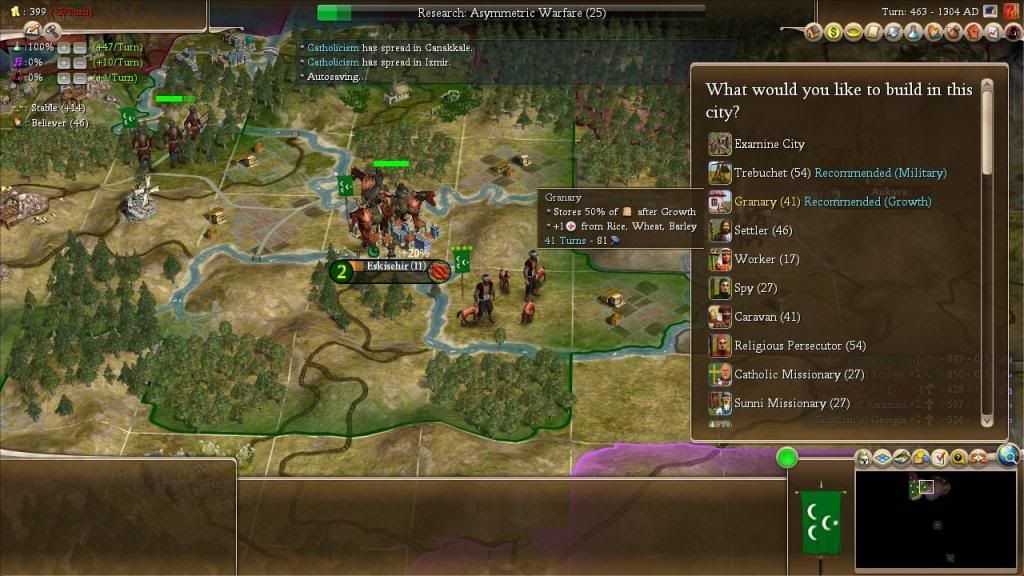

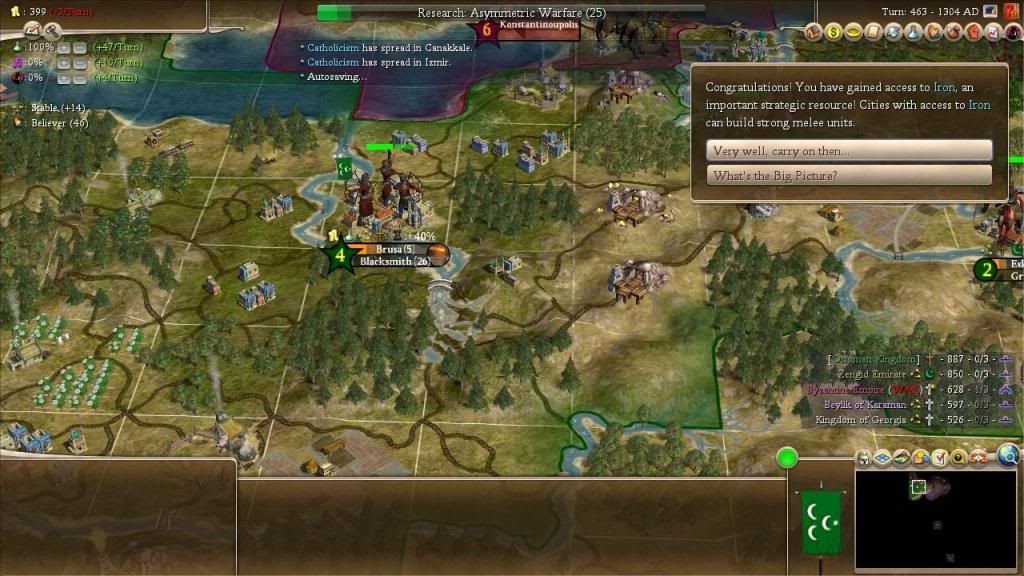
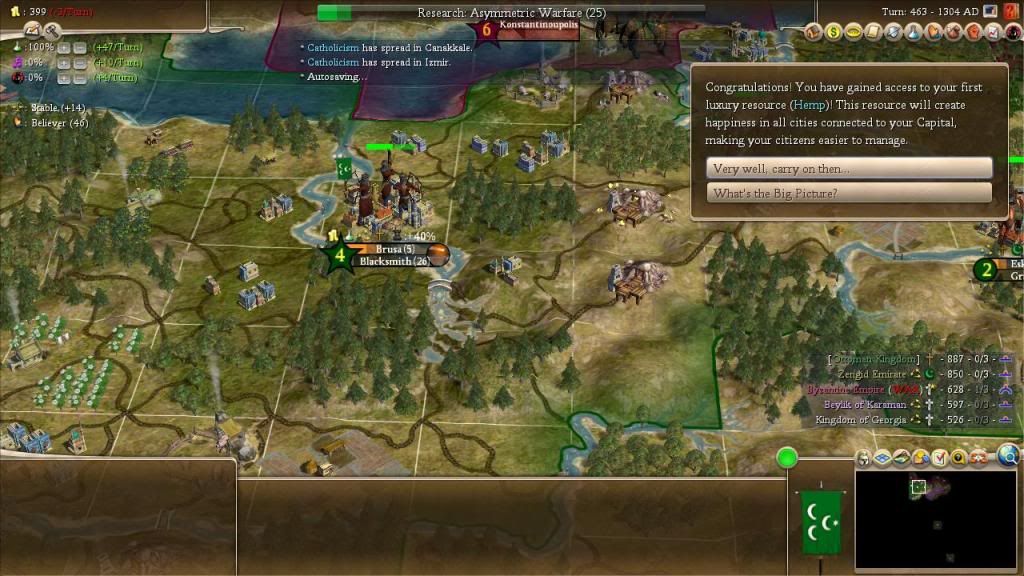

With King Osman Leading them, the Ottoman army arrived at the gates of Constantinople. The first truly great Ottoman city was within their grasp. The siege of Constantinople has begun.

Amazed by the new Catholic state, the remnants of the Crusaders, the Knights Hospitaller, arrived in Brusa to assist any and every war effort. Genoan merchants, finally with a safe place to trade, established shops in Canekkale. Infrastructure expanded in Ottoman territories as a result of these new helping hands. In response to the kindness of fellow Catholics, Osman decided to reform the government's legal and religious systems to be more dedicated to the state religion.






Envoys from the Mamluks, a military division that gained enough influence to succeed the Ayyubids, came. Though the state was Muslim, they were respectful to the growing Ottoman state. Orhan, the new King as Osman died 1824, signed a peace treaty.

Even though infrastructure was building nicely, religious minorities of Izmur, the most multi-religious city in the Ottoman Kingdom tried to rebel. Orhan let the local authorities find their own way to get things to settle down. Somehow, they managed to get the revolt to stop before too much was plundered. The men who succeeded in averting what could have potentially been a civil war were commended and sent to help capture Constantinople, where they became war heroes as well as civil heroes.


Back on the war-front, the last rounds from the trebuchet artillery force hit the Theodosian walls, destroying the defenses of the city. The trebuchet was then sent to attack the defense force of the city. Horsemen charged out, and though the trebuchets managed to destroy most of them before they reached the medieval artillery, they did damage to the weapons before being driven back. Now it was a battle of armies. Though the Ottomans lost their fair share of men, the city was finally taken. the Ottomans had just taken the city that has stood as the capital for three great Empires before it. The Ottomans would be the fourth to call it such.





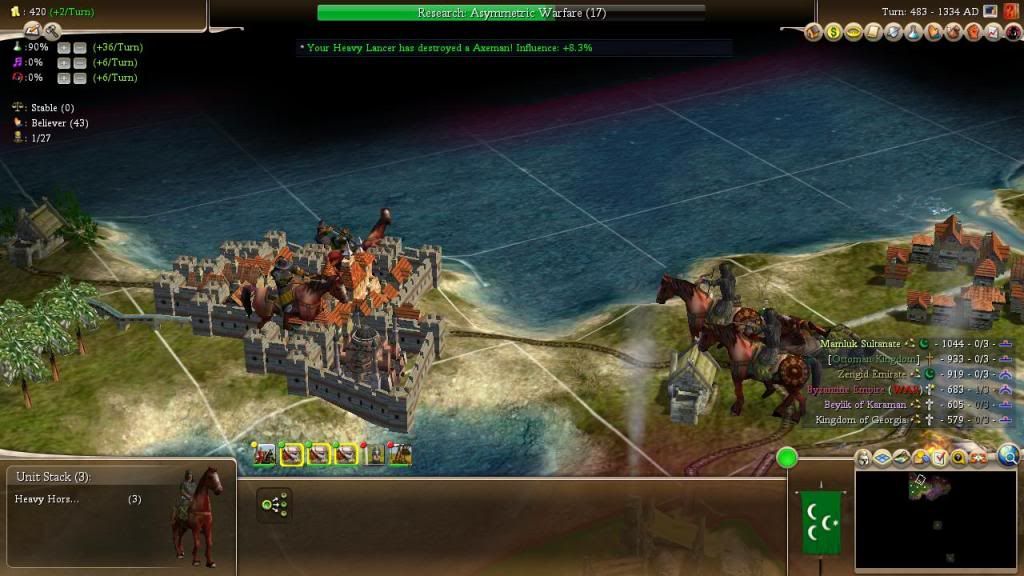



The Ottoman Catholic minorities of Anatolia finally rise to arms under the leadership of Osman Bey Ghazi, a former Muslim who had recently converted to the Christian Catholic faith. With various wars, both foreign and civil, the Byzantine Empire is coming to an end. The Catholics under Osman now seek revenge on both Orthodox and Muslim nations. With the Crusaders destroyed, they now have their mind set on three specific cities: Constantinople, Jerusalem, and Mecca.
Spoiler :

They decided to destroy their enemies, they would need assistance from the inside. The skills of Asymmetric Warfare was to be learned. To increase production in their temporary capital, a blacksmith was ordered to be built by the newly-crowned Ottoman King. Amazed at this new nation, cities around the capital joined the Ottoman Kingdom. Catholicism was spread to these regions, creating a mostly-unified Catholic state. The first ever sense the Romans to succeed at this.
Spoiler :




The main cities of these newly-joined regions began establishing infrastructure. Roads connected these cities to give merchants and armies easy traveling across the land. Resources of these regions began to be harvested and mined. The stage was set for one of the greatest powers the middle east will ever see on its soil.
Spoiler :






With King Osman Leading them, the Ottoman army arrived at the gates of Constantinople. The first truly great Ottoman city was within their grasp. The siege of Constantinople has begun.
Spoiler :

Amazed by the new Catholic state, the remnants of the Crusaders, the Knights Hospitaller, arrived in Brusa to assist any and every war effort. Genoan merchants, finally with a safe place to trade, established shops in Canekkale. Infrastructure expanded in Ottoman territories as a result of these new helping hands. In response to the kindness of fellow Catholics, Osman decided to reform the government's legal and religious systems to be more dedicated to the state religion.
Spoiler :






Envoys from the Mamluks, a military division that gained enough influence to succeed the Ayyubids, came. Though the state was Muslim, they were respectful to the growing Ottoman state. Orhan, the new King as Osman died 1824, signed a peace treaty.
Spoiler :

Even though infrastructure was building nicely, religious minorities of Izmur, the most multi-religious city in the Ottoman Kingdom tried to rebel. Orhan let the local authorities find their own way to get things to settle down. Somehow, they managed to get the revolt to stop before too much was plundered. The men who succeeded in averting what could have potentially been a civil war were commended and sent to help capture Constantinople, where they became war heroes as well as civil heroes.
Spoiler :


Back on the war-front, the last rounds from the trebuchet artillery force hit the Theodosian walls, destroying the defenses of the city. The trebuchet was then sent to attack the defense force of the city. Horsemen charged out, and though the trebuchets managed to destroy most of them before they reached the medieval artillery, they did damage to the weapons before being driven back. Now it was a battle of armies. Though the Ottomans lost their fair share of men, the city was finally taken. the Ottomans had just taken the city that has stood as the capital for three great Empires before it. The Ottomans would be the fourth to call it such.
Spoiler :









Optical
The Fall of the Eleventh
Nice work so far! Good to see this get started 

christos200
Never tell me the odds
Great update!!
hoplitejoe
Top fun-poster
- Joined
- Mar 22, 2010
- Messages
- 5,470
 Take that DoB!
Take that DoB!mayor
Heart & Mind
good writing 

MoreEpicThanYou
The most Epic.

Nice!
Seron
Warlord
Great work! 

- Joined
- Mar 14, 2011
- Messages
- 4,131
Thanks, everyone! Update to come right now:
With Constantinople in Ottoman hands, the old pretender Romans, the Byzantines, collapsed into several independent states. The Ottoman Kingdom under Orhan I was soon to be recognized as the new true Roman Empire, and Orhan crowned himself Roman Emperor. Work began to remake the damaged infrastructure of the soon-to-be Ottoman Capital.


Orhan then sent the army that took the mightiest city in the region to a nearby Thracian city, Adrianoupolis. It was taken with relative ease.
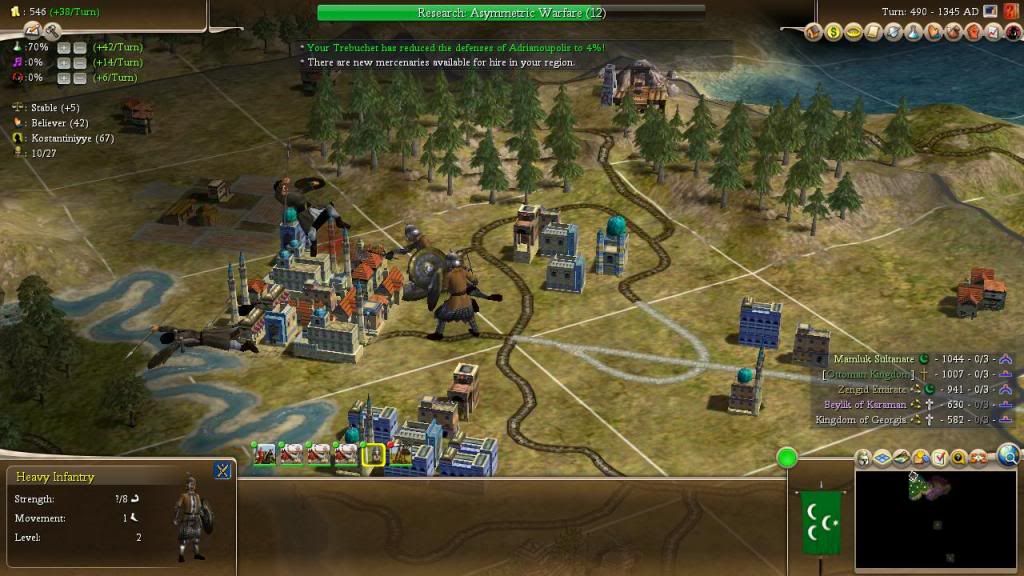

Meanwhile, Bursa was still building up. The researchers finally unlocked the secrets of Asymmetric Warfare and it was decided they start looking into the theory of the Welfare State. A famous Muslim scholar also seemed to compile his work regarding the most culturally advanced people in the region, many of which no Ottoman have ever heard of. A year later, Orhan I died. His son, Murad, tok the throne almost immediately after.




As infrastructure built further, the military academies in Brusa worked for a stronger defense, thus started the mass training of Marksmen.



As Europeans heard of the Fate of the Byzantines, Bulgarian foot soldiers entered newly-Ottoman grounds hoping to reclaim the land. Unluckily for them, the found the army encampment at the newly-named city of Edrene. They were disposed of quickly. Around the country, cities grew larger. As technological advance proceeded to start working on optics, a Mamluk Ambassador came to Murad's palace, demanding a relatively large sum of gold. He was sent out immediately. Murad had discovered his father was wrong, the Mamluks were like the rest of civilization in the Middle-East. The Ottoman Kingdom viewed almost everyone of an enemy of sorts ever sense.





After the ordeal with the Mamluk, the Ottomans decided it was time to re-unite the rest of Anatolia. War was declared on the Orthodox Karamanids. The army was quickly sent to a southern city that was just captured by the Karamanids from the rebels of the Byzantines. The army made quick work of the garrison, battle-hardened by the battle of Constantinople.


In 1389, Murad died. His son, Bayezid, lived a short rule. After him, a triumvirate began. Isa, Suleyman, and Mehmed Celebi began ther rules. Though, the period wans't vary exciting. A turkoman horde established an independent state near Eskisehir but their expansion was halted at the city walls. Cities built up more structures, and Constantinople was still under reconstruction.





In Edrene various factions were fighting over control of the city. If order wasn't restored, the city could be destroyed. The Triumvirate agreed to assist the merchants, to increase revenue and put an end to the city-threatening skirmishes. Meanwhile, the Ottoman "Crusader" army have reached the walls of the Karamanid capital of Konya. Bombardment was underway.


With Constantinople in Ottoman hands, the old pretender Romans, the Byzantines, collapsed into several independent states. The Ottoman Kingdom under Orhan I was soon to be recognized as the new true Roman Empire, and Orhan crowned himself Roman Emperor. Work began to remake the damaged infrastructure of the soon-to-be Ottoman Capital.
Spoiler :


Orhan then sent the army that took the mightiest city in the region to a nearby Thracian city, Adrianoupolis. It was taken with relative ease.
Spoiler :


Meanwhile, Bursa was still building up. The researchers finally unlocked the secrets of Asymmetric Warfare and it was decided they start looking into the theory of the Welfare State. A famous Muslim scholar also seemed to compile his work regarding the most culturally advanced people in the region, many of which no Ottoman have ever heard of. A year later, Orhan I died. His son, Murad, tok the throne almost immediately after.
Spoiler :




As infrastructure built further, the military academies in Brusa worked for a stronger defense, thus started the mass training of Marksmen.
Spoiler :



As Europeans heard of the Fate of the Byzantines, Bulgarian foot soldiers entered newly-Ottoman grounds hoping to reclaim the land. Unluckily for them, the found the army encampment at the newly-named city of Edrene. They were disposed of quickly. Around the country, cities grew larger. As technological advance proceeded to start working on optics, a Mamluk Ambassador came to Murad's palace, demanding a relatively large sum of gold. He was sent out immediately. Murad had discovered his father was wrong, the Mamluks were like the rest of civilization in the Middle-East. The Ottoman Kingdom viewed almost everyone of an enemy of sorts ever sense.
Spoiler :





After the ordeal with the Mamluk, the Ottomans decided it was time to re-unite the rest of Anatolia. War was declared on the Orthodox Karamanids. The army was quickly sent to a southern city that was just captured by the Karamanids from the rebels of the Byzantines. The army made quick work of the garrison, battle-hardened by the battle of Constantinople.
Spoiler :


In 1389, Murad died. His son, Bayezid, lived a short rule. After him, a triumvirate began. Isa, Suleyman, and Mehmed Celebi began ther rules. Though, the period wans't vary exciting. A turkoman horde established an independent state near Eskisehir but their expansion was halted at the city walls. Cities built up more structures, and Constantinople was still under reconstruction.
Spoiler :





In Edrene various factions were fighting over control of the city. If order wasn't restored, the city could be destroyed. The Triumvirate agreed to assist the merchants, to increase revenue and put an end to the city-threatening skirmishes. Meanwhile, the Ottoman "Crusader" army have reached the walls of the Karamanid capital of Konya. Bombardment was underway.
Spoiler :


Optical
The Fall of the Eleventh
Istanbul would be unrealistic. It's only been named that since the early 1900s IIRC - another Firaxis blunder.
Mosher
Mushroom dad
Yeah, it was renamed Istanbul in the first decade of the 1900s. Constantinople is its true name!
christos200
Never tell me the odds
Again great upadate.
mayor
Heart & Mind
Great Update
Not quite, originally it was called Byzantium/Byzantion, when it became the Capital of the Roman Empire it was officially renamed to Nova Roma, but then the name Constantinople caught on and that stuck until Istanbul off course
until Istanbul off course 
Yeah, it was renamed Istanbul in the first decade of the 1900s. Constantinople is its true name!
Not quite, originally it was called Byzantium/Byzantion, when it became the Capital of the Roman Empire it was officially renamed to Nova Roma, but then the name Constantinople caught on and that stuck
 until Istanbul off course
until Istanbul off course 
Omega124
Challenging Fate
I don't get the rename. Istanbul is a (Medieval) Greek word that roughly means "In the City". So, if they were trying to Turkishify the city, they utterly failed. Not to mention that Constantinople is a better name to begin with.
Similar threads
- Replies
- 48
- Views
- 6K
- Replies
- 271
- Views
- 15K
- Replies
- 0
- Views
- 2K
